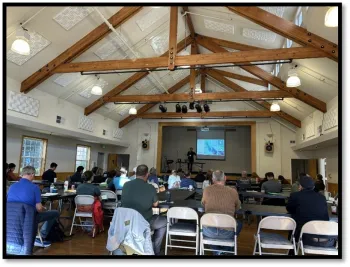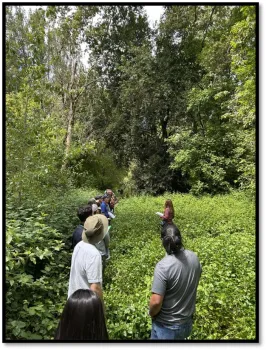ISHB Science and Strategy Convening Draws Land Managers, Scientists, and Decision Makers to Felton
New Detection of Greater Shothole Borer Spurs Urgent Regional Collaboration and On-the-Ground Action
In response to the identification of a new species of invasive shothole borer (ISHB) for the western United States, the “Greater Shothole Borer” (Euwallacea interjectus), in Felton late last year, the University of California (UC) Cooperative Extension and partners at UC Davis and the County of Santa Cruz organized a regional “Science and Strategy Convening” in May. Over 50 attendees came together to learn about the new pest and other closely related invasive shothole borer (ISHB) species present in California and the region.

The goal of the event, funded by a USDA Renewable Resources in Extension Grant, was to bring together statewide experts to provide extension guidance and to get feedback from over 50 local natural resource managers, city and county officials, and property owners on how we can launch the most effective response and prevent further spread. The event included a morning of presentations, a guided and self-guided walking tour, and afternoon science and strategy session.
Walking Tour
During the convening, Dr. Shannon Lynch and Dr. Beatriz Nobua Behrmann, worldwide experts on invasive pests and ISHB, guided attendees through the infestation to review identification tips, discuss best management practices, and observe the variable effects and intensities the beetle-pathogen complex can have on different species present in local riparian systems.
As part of the convening, a self-guided walking tour was created for members of the public to learn the basics of ISHB identification, monitoring, and management. The tour takes you along the Zayante Trail in Henry Cowell Redwoods State Park, guiding you through a mile hike to see the effects of the greater shothole borer in and around Henry Cowell Redwood State Park firsthand. The walking tour and associated map, created as part of this project, are now available for your use below.

Science and Strategy Convening and Needs Assessment
The event was capped by an afternoon session where the participants identified core needs for their organizations to respond to local infestations of ISHB. The participants broke out into groups and covered four topics in interactive discussions led by statewide and regional experts: 1) outreach and education, 2) survey, detection, and rapid response, 3) greenwaste and firewood as pathways, and 4) research. For each topic, the participants identified the top needs, challenges, and opportunities and strategized how regional resources could be applied to address them. Findings from these sessions will help lay the foundation for more coordinated action in the months and years ahead as we manage these pests in our forest systems.
While we never want to see a new invasive pest in our region, events like this give me hope. As a Regional Forest Advisor, I’m encouraged by how committed our community is to fostering healthy forest ecosystems and tackling threats like the invasive shothole borer.
New Educational and Extension Resources Now Available
Self Guided Walking Tour Resources
Self Guided Tour Map (Georeferenced for use in mapping apps, i.e. Avenza or similar)
To learn more about ISHB — including the newly introduced greater shothole borer — explore the new resources below and visit www.ISHB.org.
